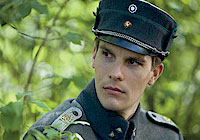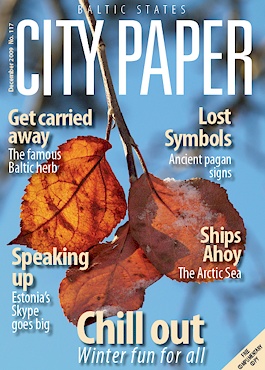Independence on the Big Screen
 No, this is not about that film where aliens blew up the White House before being chased off by the American President, flying a fighter jet all by himself on the United States' Independence Day. This is about how Estonian filmmakers have portrayed their country's own struggle for independence on film. Space aliens not included. The first movie to be made in independent Estonia after August 1991 was Darkness in Tallinn (Tallinn pimeduses).
No, this is not about that film where aliens blew up the White House before being chased off by the American President, flying a fighter jet all by himself on the United States' Independence Day. This is about how Estonian filmmakers have portrayed their country's own struggle for independence on film. Space aliens not included. The first movie to be made in independent Estonia after August 1991 was Darkness in Tallinn (Tallinn pimeduses).
Fittingly, it is set in the first days following Estonian independence. Perhaps less fittingly, it was directed by a Finn, Ilkka Jarvi-Laturi, who sadly has only made one feature since. From the very first scene, Darkness in Tallinn plays as a stylish caper film. It starts with the mob meeting in the TV Tower on the outskirts of Tallinn, where they plan to steal Estonia's gold reserves, which are about to be brought back from Paris. The hero is an electrician who gets caught in the middle, and is forced by the gangsters to switch off all the lights in the city.
The film begins in black and white but switches to color when the lights go on again; perhaps the most effective use of color vs. black and white since The Wizard of Oz in 1939. There, color was used to symbolize the stepping out of dull reality to a magical land, here, one can only interpret the light and color coming to Tallinn as symbolizing independence. The film plays with some post-Soviet film elements, that would later become standard; the hero is a common working man and the gangsters are exceptionally brutal. Darkness in Tallinn was premiered at the Toronto film festival in 1993 and went on to win the Silver Alexander at the Thessaloniki Film Festival.
Surprisingly, it wasn't screened in Estonia until February of this year. In the 15 years since Darkness in Tallinn's revolutionary appearance, Estonia's film industry has progressed and Estonian directors now feel confident to make their own films set during the struggle for independence. This applies both to the War of Liberation that lasted from 1918-20, as well as the struggle for what is called the restoration of independence, which was finally achieved in August of 1991.
Schoolboys and Lenins
One of the best Estonian films to reference the Estonian struggle for independence, is also one of the first to be made about the topic.
All My Lenins (Minu Leninid) came out in 1997 on the 80th anniversary of the Russian Revolution. The film is about an Estonian spy working for the Germans in World War I who has a personal agenda of creating an independent Estonia; the tag line is, "What is the Historical Truth? God knows". The Estonian spy establishes a school of Lenin clones, and classes are actually taught by the Bolshevik leader himself from his exile in Switzerland! It is mostly a one joke film, but the joke is a good one. It also scores points for having all the characters speak their native languages, mostly German or Russian.
Less successful is a film that tries to give the War of Independence the full, epic treatment. Names in Marble (Nimed marmortahvlil) is one of the most expensive movies made in Estonia, and it even features Finnish film star Peter Franzen, best known from the war film Ambush (Rukajarven Tie), as the commander of the Finnish volunteer forces. Even though he has a small role in Names in Marble, his face is prominent on the Finnish version DVD cover, and one can only wonder if his involvement was to make the film more marketable north of the gulf. As its name implies, it is a somewhat more sombre effort than All My Lenins.
It starts out promisingly enough, with a group of students climbing Tartu's town hall to replace the German flag with the new Estonian flag. Credibility, however, is quickly lost as the boys outwit the Germans in a Hogan's Heroes-like fashion, and it never quite recovers. The film is an ambitious attempt to pull together the various threads of the Estonian restoration for independence, with the tale of two brothers, one on the nationalist side and the other supporting the Soviets. It even finds space to mention the role of the Red Latvian riflemen.
Even though the film is worthwhile as a period piece, it is undone by a clunky script, rather than the absence of funds for major battle scenes.
August to December
2005 saw the appearance of two films dealing with different periods in Estonia's struggle for independence. One, Malev, is actually set in the period when Estonias initially lost their country to German crusaders in the 13th century. Like All My Lenins, it is a historical comedy. Unlike Lenins, it does not manage to come up with a single good joke.
Far better is the "documentary drama" August 1991, made by ETV, Estonia's state television channel. Not surprisingly, the main protagonists are a group of ETV journalists who are following the August coup in the Soviet Union that would lead to Estonia's independence. Despite having cost much less to make than Names in Marble, it manages to be both a better historical overview of the events it depicts as well as a more exciting movie. Its best scene is the nerve wracking stand off in the TV tower.
This is based on actual events, but also seems symbolic of filmmaking in Estonia coming full circle from the beginning scene of Darkness in Tallinn. Roughly the same events are depicted in the documentary The Singing Revolution (Laulev Revolutsioon), which came out in early 2007. While the film is a fair introduction to the events of 1988-91, including interviews with some of the main protagonists, it is somewhat weighed down by heavy patriotism. The acted out August 1991 packs a more powerful punch, both as a historical depiction and as a movie.
The next Estonian historical epic, December Heat (Detsembri kuumus), is about an attempted communist coup in 1924. Earlier this year, Estonia celebrated 90 years since the country's first declaration of independence. Not quite coincidentally, this is also the year that Latvia celebrates its 90 year anniversary. Last November 11 th, the anniversary of a climatic battle in the Latvian's War of Independence in 1919, the film Defenders of Riga (Riga Sargis) was released. It is the most expensive film in Latvian history but the investment soon paid off, as it has also managed to become the highest grossing film in Latvian history.
Not everyone is impressed, though. Variety writes: "Similar in spirit to Estonia's Names in Marble, the picture is the kind of bland historical rallying cry that every nation needs to make before moving on: stirring for audiences raised on tales of liberation, but unimpressive for those outside her borders."
Big Brother Shows How It's Done
Finland, the only part of the former Russian Empire's Baltic Provinces to preserve its independence, also celebrated its 90 years on December 6th of last year. A week earlier, the film Border 1918 (Raja 1918) was premiered. Finland's declaration of independence was followed by a civil war between the Red communists and the White nationalists. As the film starts, it seems to favor the Whites, showing the Red leaders executing men who are unwilling to sacrifice themselves to a lost cause. However, the tables are soon turned, as we move on to Whites executing defenceless Red prisoners.
The film refuses to make easy judgements; the only conclusion is that there is no good side in a war. The White captain, Baron von Munck, is sent to the frontier of Russia, and we see how the establishment of new borders tears families and former neighbors apart. Things turn from bad to worse as refugees from the Russian civil war appear, and the very idea of nationality is questioned. Only Finns are allowed to pass to safety, but as there is no telling who is what in this reckless situation, a trivial thing, like an accent, can determine if people are deemed worth saving or not. Yet, more executions follow, as the Finns resort to even tougher measures.
But surely, you may ask, this had to be done at some point, to stake out the county's natural border? This idea is soon dispelled. There is no such thing as a natural border. The White Finns, supported by the Germans in the civil war, are little more than puppets themselves and are only saved by Germany's collapse in World War I from becoming a virtual German colony. Our hero eventually finds out that the Whites and the Germans aim to march on St. Petersburg and hence move Finlands border as far east as it can be pushed through force of arms. The symbols of nationality also get short shrift. When the new Finnish flag is presented to the border station, Captain von Munck calls it an ugly, degenarate piece of modern art. Before it's all over, the Finns are reduced to shooting naked women.
The film does not let up until the final scene, when the representatives of Red and White Finland meet at a presidential party, the two sides having to build the new country together. But in the final, powerful image, they still refuse to shake hands. The film is even more remarkable for the fact that the originator of the story, Jorn Donner, who as producer of Bergman's Fanny and Alexander was the first Finn to win an Oscar, was until recently a member of the Finnish parliament. It will probably take a long time before the Estonians and the Latvians are able to take such an unbiased and unflinchingly honest look at their own Wars of Independence, the tragedies that always come with wars and the drawing of borders.
Even if they are fought for high ideals, innocence, as Oliver Stone once put it, is the first casualty of war. For the time being, Border 1918 remains the best film made by anyone anywhere, so far in this century.
By Valur Gunnarsson




